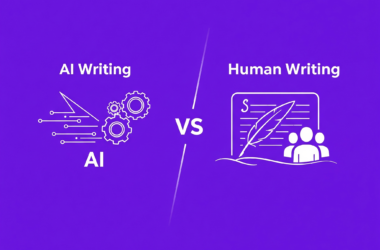Table of Contents
- Demystifying AI Writing Tools
- AI and Its Use Cases in and around Writing
- How to Use AI for Content Writing?
- Popular AI Tools for Content Writing
- How to Effectively Integrate AI Tools into Content Creation Workflow?
- Best Practices for Using AI Tools in Content Writing
- The Future of AI in Content Creation
As AI becomes more prevalent, content marketing is embracing it wholeheartedly. This not only revolutionizes the way content is created but also offers numerous benefits.
AI writing tools, in this context, have emerged as powerful aids for content creators, offering a plethora of functionalities to streamline and enhance the content writing process.
In this post, we cover how to use the power of AI tools for content writing. We’ll also explore insights on popular tools, optimal strategies, the evolving field of AI in content creation, and beyond.
Read on!
Demystifying AI Writing Tools
AI-powered content writing tools streamline the creation process for various platforms like social media, blogs, emails, and websites. However, grasping the fundamentals of these tools is crucial before diving in.
These tools improve the writing’s quality by minimizing language errors and giving suggestions for overall structure, tone, and style. Moving to their more advanced feature, AI tools for content writing can generate entire content from scratch.
Let’s look at some key facts and trends regarding the relevance of using AI tools for content writing:
- The global AI market value is projected to grow to $267 billion by 2027, and 85% of users claim that they generally use AI tools for article writing and content creation.
- AI is expected to have a CAGR growth of 37.3% between 2023 and 2030
- 47% of businesses claim to use AI tools for content writing, while 28% of them use them for design elements.
- 87.7% of B2C and 81.5% of B2B businesses are expected to use AI tools to enhance their content writing sections in 2024.
Thus, writers are not required to spend time on mundane tasks like before. The best part? The writers get room for creativity.
For example, Zoom uses AI companion tools in team chats or Zoom emails to ease the messaging process by using input from employees or clients. Many other businesses have also started using AI in marketing to improve their professional writing in automated chats.
AI and Its Use Cases in and around Writing
Let’s look into some use cases that depict the relevance of how AI has revolutionized content writing:
Brainstorming
Check out how ChatGPT just came up with Sassy SEO with its enhanced NLP capabilities. Such tools can generate text, improve website structure, and analyze consumer queries.
Text Generator tools help create original, plagiarism-free content within seconds. They can get information from a large database and create content best suited to their needs.
Writing
AI writing assistants like Grammarly or ProWritingAid can help improve writing quality by suggesting corrections for grammar, punctuation, and style. They can also offer insights on readability and tone.
Editing
Nothing beats tools like Grammarly and Hemingway Editor that can make text editing faster and more efficient for writers. These resources help writers in
- Transitioning complex statements
- Converting passive voice and adverb-based sentences into clear, concise, and readable content
- Offering spell-check and basic grammar-based suggestions
- Helping writers with better fluency and spelling, accuracy, and style-checking
SEO Assistance
One of the key objectives of building robust content is to enhance search engine visibility. This means it is vital for writers to use compelling keywords in meta descriptions, content structure, and even CTAs to improve SEO performance.
Tools like Clearscope and SurferSEO can help writers optimize their content with SEO to outrank their competitors. They can provide you with target keywords and provide SEO analysis.
Research
There is a plethora of resources that writers can refer to on the web. Open Educational Resources, research articles, academic papers, data sources, and verified articles can help writers convert complex topics into simple explanations. They can further add relevant and verifiable facts to strengthen the authenticity and credibility of the write-up.
Tools like ResearchGate, NCBI, and Scholarcy can help writers highlight key points, suggest related research materials, offer links to other related and effective content, provide verifiable research and experimentation, and summarize complex topics.
Plagiarism Check
The last thing a writer could ever want is to deliver content that is copied or inspired. Originality of content is imperative and tools like Turnitin, QuillBot, and SmallSEOTools help them maintain that.
These tools detect plagiarism by comparing your content with a large database of online content so that it remains original across the web. Whether plagiarism or intentional or unintentional, these tools help content creators maintain originality and uniqueness and eliminate any matches with existing content.
Enhancing Readability
Writers may have a strong knowledge of concepts and the skills to jot down their thoughts into words. But they also need the knack to enhance the readability of the content, make it engaging for the readers, and make the content clearer.
Long paragraphs, poor sentence formation, using passive voice structures, or adding complex statements can hamper readability, Tools like Readable, Slick Write, and ProWritingAid help you write engaging and readable content. These tools:
- Help improve the clarity of your text and evaluate readability scores
- Offer suggestions to make the content easier to understand
- Highlight complex sentences and common errors
How to Use AI for Content Writing?

Businesses and writers are plugging in AI-generated content to amplify their brand voice.
Here’s a detailed exploration of how AI can revolutionize content creation:
1. Content Creation
Human minds are enormously capable of advancing creativity and innovation. However, when it comes to writing, getting the benefit of well-researched support from a vast array of content resources using AI tools, further enhances content writing skills.
AI tools for content writing can save the day with their large language model to brainstorm and generate ideas per requirement. Here are some outcomes that can be expected from content brainstorming:
Beat the Blank Page Blues: Generating Content Ideas with AI
Leveraging AI tools for content writing empowers creators to:
- Overcome ‘writer’s block’ with AI-powered brainstorming, eliminating the struggle to organize thoughts and kickstarting the writing journey.
- Embrace AI-powered content generation platforms like OpenAI’s GPT-3 to explore new realms of creativity and broaden content creation possibilities.
- Tap into AI to enrich content credibility and depth by referencing diverse sources, as advocated by thought leaders like Seth Godin.
- Boost idea exchange and streamline content creation workflows, fostering synergy and innovation from ideation to publication.
Tailoring Content to Your Audience: AI-powered Keyword Research
In the era of cutting-edge technology, curating content that resonates with the target audience is challenging. It is necessary to incorporate suitable keywords to create meaningful and SEO-friendly content.
AI-powered keyword research tools traverse enormous data sources to find the best-fitting keywords for websites or social media content. This enhances the quality of content and attracts heavy traffic to the website. Some commonly used tools are Surfer Content Editor, Semrush, Marketmuse, and Cocolyze.
2. Content Creation and Writing

AI tools allow automated content creation, and this AI-generated content is primarily SEO-aligned to ensure high visibility on the search result page. This cost-effective approach generates content according to the brand image to boost engagement.
Here are the reasons why AI tools are considered for content creation and writing:
- Speed and Efficiency: AI content tools streamline repetitive tasks, wherein bloggers spend about 2.81 hours writing a 2,000-word post, compared to 4.02 hours for those who don’t use AI.
- Consistency: Generative AI ensures uniformity across large volumes of content. In 2023, 58% of marketers aimed to utilize AI for generating SEO content.
- Accuracy and Personalization: An impressive 92% of companies use AI-driven personalization.
- Scalability: Writers spend about 30% less time on blog posts, freeing up time for creative and strategic tasks. Google values high-quality content E-E-A-T, regardless of whether it’s AI-generated or human-written.
Outlining Made Easy: AI-powered Blog Post Structures
Neil Patel says, “AI helps you come up with ideas. And, AI helps you create content faster. But if you use AI to write your content, in most cases you will get less traffic.”
While AI may not drive significant traffic when used for content writing alone, it excels at creating outlines. AI-powered tools craft comprehensive frameworks with unique headings, maintaining brand identity and streamlining content creation.
By utilizing AI-powered blog post structures, creators can streamline their workflow, save time, and maintain a cohesive brand voice throughout their content.
AI-generated Drafts: Jumpstart the Writing Process
Studies show that 46% of businesses already utilize AI tools for content writing. Additionally, research shows that almost 95% of customer interactions will be powered by AI by 2025. This highlights the growing importance and widespread adoption of AI in content creation.
When drafting content, it is crucial to separate writing from editing. After getting a unique and well-written outline, using artificial intelligence to create drafts can save time and effort without compromising quality. AI-generated drafts are more organized and sophisticated compositions of the given narrative.
3. Editing and Polishing Your Content
Using an AI-powered writing assistant is the best way to filter content before presenting it to readers. From enhancing basic formatting to setting style or tone, AI-powered editing tools are the best companion in improving readability. Their advanced features include checking factual accuracies and simplifying the text. L
Let’s look at some facts first:
- Businesses demand nearly 90% accuracy in their content-related assignments, while 72% believe AI excels at handling repetitive tasks. Moreover, 71% perceive AI as more innovative than humans.
-
80% of executives believe AI can enhance productivity, and 66% claim AI effectively mitigates human errors by processing vast amounts of data.
Grammar Guru: AI-powered Proofreading and Editing

AI-powered proofreading and editing tools allow adjustments and modifications in style, voice, and tone of drafts addressing the target audience.
With Grammarly and QuillBot being widely used, other tools include Languagetool, GrammarCheck, Scribbr, and more.
These AI tools for content writing remove errors in grammar, spelling punctuation, and redundancies with suggestions to make the draft more elegant, consistent and persuasive. It is necessary to check for plagiarism and factual inaccuracies with AI-generated content.
AI-powered tools for editing assist in:
- Streamlining the editorial process and performing content research
- Elevating the quality of proofreading and editing
- Conquering writer’s block, enriching articles
- Boosting reader engagement, and improving Google’s E-E-A-T value
- Creating compelling article titles and developing customized GPT models
- Recommending related readings and identifying dull paragraphs or weak messages
- Refining content and enhancing workflow efficiency for content teams
- Crafting content outlines and summarizing reports for efficient organization
- Delivering thorough editing and assisting with business writing projects
- Providing alternative writing suggestions and improving content readability and SEO
Enhancing Readability: Using AI for Clearer Communication
Communication is the most important component of content marketing. It is essential to convey the message to the target audience with the right content strategy.
AI-powered readability tools enhance the overall quality by smoothing transitions and the flow of the content. It involves improving readability through
- word choice
- sentence structure and length
- appropriate formatting
- simplifying complex sentences and paragraphs
- reducing technical jargon
These AI tools for content writing help readers grasp the clarity of the message easily. It reduces the confusion in the minds of readers and, hence, increases engagement.
Standard tools for enhancing readability are HyperWrite, AISEO, and Grammarly. By piloting AI content generation tools, many businesses reduce muddiness in their content and increase conversion rates.
Popular AI Tools for Content Writing
Below are the top five AI tools for content writing that are widely used by content creators:
1. Grammarly

Grammarly is an outstanding AI tool for content writing that analyzes and enhances your content.
Top Features
- It offers advanced features like suggestions on spelling, clarity, vocabulary, grammar, and readability.
- The best part of using Grammarly is that it also plugs in as an extension on multiple web browsers.
- It allows content creators to focus more on article cohesion, adequate comprehension, critical thinking, creativity, and demonstration of learning.
Pricing
Besides the free package, Grammarly offers a premium Plan and a Business Plan, which can go up to $15 per month when billed annually and $25 when billed monthly.
2. Copy.ai

Copy.ai is one of the most popular AI tools for content writing that works on a GPT-3 model.
Top Features
- It provides features like availability in over 25 languages, 90+ copywriting templates, and a built-in plagiarism checker.
- This tool helps in confounding writer’s block and saves lots of time.
- It automatically makes your prompts better, and lets you personalize your brand voice for authentic messaging.
Pricing
You get a Free Plan limited to 2000 words, a Starter Plan at $49 per month, and an advanced plan at $249 per month with exclusive features.
3. Rytr

While writing a short piece of content or generating an innovative idea for copy, Rytr is best known for enhancing content with AI.
Top Features
- It boasts 80 lakh+ copywriters, businesses, and marketers for compelling and unique content.
- The features offered by Rytr include free generation of 10k words per month, over 20 different tones of voice, 30+ languages, and plagiarism-free drafts.
- This AI-powered writing assistance is best for business emails, e-commerce writing, and social media copy
Pricing
You get a plethora of free services. For a yearly plan,. you get the benefit of two free monthly plans, and for monthly plans, you have the leverage to cancel them anytime. You can try the unlimited generations plan at $7.50 per month or the Premium plan at $24.16 per month with extra, exclusive, and unlimited features.
4. Jasper

Jasper is a meticulously designed AI tool for impressive AI-assisted content for brand voice.
Top Features
- It helps you brainstorm, generate, rephrase, or remove plagiarism and promotes team assistance and project management
- Jasper brings a competitive advantage to brands by offering 90+ templates, ensuring privacy and ethics
- This AI tool is ideal for social media posts, blogs, and emails to accelerate organic traffic
Pricing
You can start with a 78-day free trial and then opt for their Creator Plans for $39 per month, Pro Plans for $59 per month, and Business Plans with unlimited feature usage (rate fixed after consultation)
5. Quillbot

QuillBot is one of the most trusted AI tools for content writing by professional writers, marketers, and B2B entrepreneurs.
Top Features
- Quillbot is ideal for re-writing content with other tools like a paraphraser, plagiarism checker, AI detector, proofreader, grammar checker, and spell checker
- Users can accumulate all their work in one place with a smooth and user-friendly interface
- It can employed as an extension on Edge, Chrome, and Word add-in
Pricing
Most of the tools are free, with prime features and upgrades available through Premium plans. QuillBot Premium offers competitive pricing wherein the annual plan costs $8.33 monthly, the semi-annual plan costs $13.33 per month, and the monthly plan costs $19.95.
How to Effectively Integrate AI Tools into Content Creation Workflow?
The primary goal of every business is to build a strong brand image with SEO-friendly content and high user engagement. To do so, integrating AI tools into the content creation workflow can be seen as a game-changer.
The process of utilizing AI tools for content writing is as follows:
- First, select an AI tool that can assist in automated content creation without compromising quality
- Second, use AI tools to generate ideas and relevant keyword research for the desired content strategy
- Third, design content outline using AI tools
- Fourth, create the first draft using the formulated outline and revise it using AI suggestions
- Fifth, incorporate AI tools for content writing to proofread and increase readability
- Sixth, explore different methods provided by AI tools to approach the target audience
- Seventh, observe the AI analytics and follow up
Businesses and brands can increase organic traffic and visibility to their website by successfully integrating AI tools into the content workflow.
In this regard, you can use Wittypen’s free AI tools to revolutionize your content creation process, from brainstorming innovative ideas to refining your final drafts. This way, you can enhance efficiency, improve content quality, and ultimately achieve your business objectives.
Best Practices for Using AI Tools in Content Writing
Follow the practices mentioned below to refine your approach to using AI tools in content writing:
1. Browse Through Different AI Tools
The first step in ensuring high productivity and the desired quality of content is selecting the best AI tools for the objective. You must select the right AI writers depending on the format of content like blog posts, emails, ads, website articles, or video templates.
2. Be Specific with Inputs
AI tools are trained to produce the desired outcome by learning behavior through inputs. You need to articulate specific and detailed inputs or queries, that will enhance the quality of the content generated.
3. Keep Experimenting with the Drafts
Do not settle with the first draft, keep iterating and generate multiple variations of the draft. It may be tiresome and time-consuming but you can find more refined and creative content with every variation. You can use and blend discoveries according to your requirements.
4. Try to Define the Target Audience
AI tools work on data insights, they search all over the internet to generate content. You must define the target audience, which will narrow your search and present you with more precise and innovative content.
For better quality content, make sure you supervise, monitor, and control AI tools for content writing according to your preferences and requirements.
The Future of AI in Content Creation
When it comes to utilizing AI tools for content writing, it’s all about maximizing efficiency and quality. As AI becomes increasingly integrated into content marketing, understanding how to use its power is essential.
However, the challenges of authenticity, credibility, and ethicality should be addressed carefully to create synergy between humans and AI tools for content writing.
If you’re on the lookout for a reliable team of writers who can navigate these challenges seamlessly, Wittypen can help. Our talented pool of freelance writers is committed to delivering content that not only meets your needs but also upholds the highest standards of authenticity, credibility, and ethicality.











